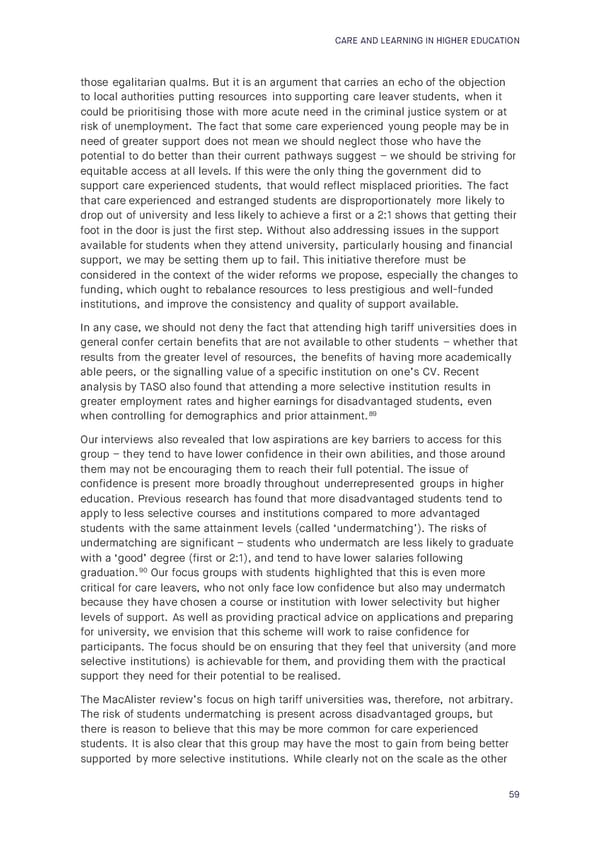CARE AND LEARNING IN HIGHER EDUCATION those egalitarian qualms. But it is an argument that carries an echo of the objection to local authorities putting resources into supporting care leaver students, when it could be prioritising those with more acute need in the criminal justice system or at risk of unemployment. The fact that some care experienced young people may be in need of greater support does not mean we should neglect those who have the potential to do better than their current pathways suggest – we should be striving for equitable access at all levels. If this were the only thing the government did to support care experienced students, that would reflect misplaced priorities. The fact that care experienced and estranged students are disproportionately more likely to drop out of university and less likely to achieve a first or a 2:1 shows that getting their foot in the door is just the first step. Without also addressing issues in the support available for students when they attend university, particularly housing and financial support, we may be setting them up to fail. This initiative therefore must be considered in the context of the wider reforms we propose, especially the changes to funding, which ought to rebalance resources to less prestigious and well-funded institutions, and improve the consistency and quality of support available. In any case, we should not deny the fact that attending high tariff universities does in general confer certain benefits that are not available to other students – whether that results from the greater level of resources, the benefits of having more academically able peers, or the signalling value of a specific institution on one’s CV. Recent analysis by TASO also found that attending a more selective institution results in greater employment rates and higher earnings for disadvantaged students, even when controlling for demographics and prior attainment.89 Our interviews also revealed that low aspirations are key barriers to access for this group – they tend to have lower confidence in their own abilities, and those around them may not be encouraging them to reach their full potential. The issue of confidence is present more broadly throughout underrepresented groups in higher education. Previous research has found that more disadvantaged students tend to apply to less selective courses and institutions compared to more advantaged students with the same attainment levels (called ‘undermatching’). The risks of undermatching are significant – students who undermatch are less likely to graduate with a ‘good’ degree (first or 2:1), and tend to have lower salaries following graduation.90 Our focus groups with students highlighted that this is even more critical for care leavers, who not only face low confidence but also may undermatch because they have chosen a course or institution with lower selectivity but higher levels of support. As well as providing practical advice on applications and preparing for university, we envision that this scheme will work to raise confidence for participants. The focus should be on ensuring that they feel that university (and more selective institutions) is achievable for them, and providing them with the practical support they need for their potential to be realised. The MacAlister review’s focus on high tariff universities was, therefore, not arbitrary. The risk of students undermatching is present across disadvantaged groups, but there is reason to believe that this may be more common for care experienced students. It is also clear that this group may have the most to gain from being better supported by more selective institutions. While clearly not on the scale as the other 59
 Care and Learning in Higher Education Page 59 Page 61
Care and Learning in Higher Education Page 59 Page 61